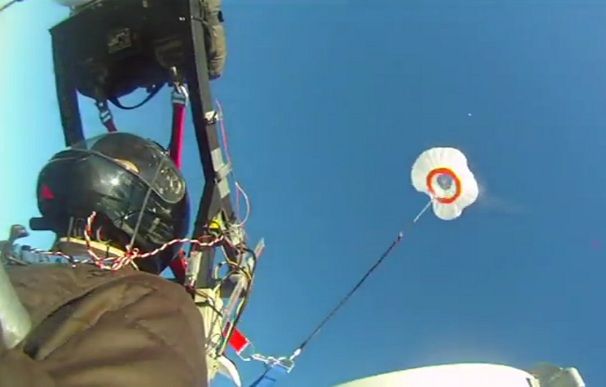New Jetpack Flies to Record Height for Parachute Test

Anyone who dreams of flying in a personal jetpack may rest assured that such a futuristic vision doesn't come without safety features. A Martin Jetpack has soared to record heights so that it could test a ballistic parachute on the way back down to Earth.
The jetpack carried a dummy pilot (rather than a human daredevil) during its first parachute test above Canterbury, New Zealand on May 21. Its creators at the Martin Aircraft Company say the unmanned drone demonstration represents a crucial flight-testing step before the company begins delivering to military and emergency responder customers within the next year-and-a-half.
"In the past two years, we’ve gone from unveiling a world leading invention to a company on the verge of international commercialization of both the manned and unmanned versions of the jetpack," said Richard Lauder, CEO of Martin Aircraft. [Read more: 10 Sci-Fi Predictions That Came True ]
The Martin Jetpack can climb more than 1,000 feet (305 meters) per minute and cruise at 62 mph (100 km/h), as well as fly for 30 minutes or more. But it rose at just 800 feet per minute (4 m/s) during the latest test so that chase helicopters could keep up throughout the six-minute climb, according to Glenn Martin, inventor of the Martin Jetpack.
A pilot aboard one of the chase helicopters directed the unmanned jetpack's flight by using radio control — not unlike flying a radio-controlled toy airplane or helicopter.
Once the jetpack had hit its record-breaking altitude of 5,000 feet (1,500 m), it came back down to 3,000 feet (914 m) above ground level and popped open the parachute for its descent.
The jetpack suffered some damage upon impact, but the pilot would have likely walked away from the simulated emergency landing, according to the Martin Jetpack creators. They expect the safety to improve once they test the jetpack with a specially designed ballistic parachute, as opposed to the off-the-shelf version used during the latest test.
Get the world’s most fascinating discoveries delivered straight to your inbox.
Future customers in the military or emergency response sectors might use the nimble but hover-capable jetpack without a human pilot for situations deemed to be too dangerous for people. Ordinary customers can get a taste of the future as well, but only if they can pay the expected $100,000 price tag.
This story was provided by InnovationNewsDaily, a sister site to Live Science. Follow InnovationNewsDaily on Twitter @News_Innovation, or on Facebook.



